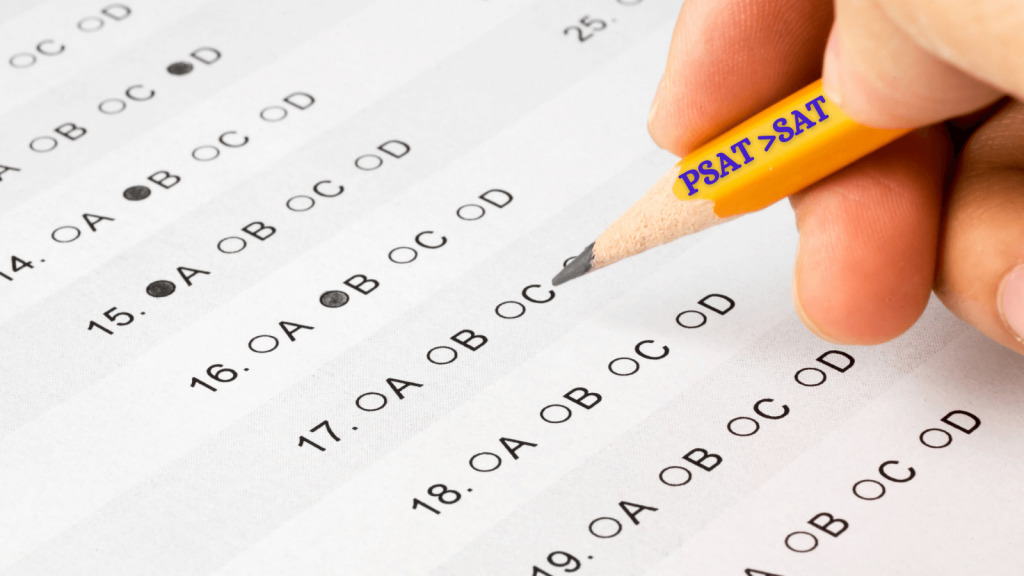Student-centric advice and objective recommendations
Higher education has never been more confusing or expensive. Our goal is to help you navigate the very big decisions related to higher ed with objective information and expert advice. Each piece of content on the site is original, based on extensive research, and reviewed by multiple editors, including a subject matter expert. This ensures that all of our content is up-to-date, useful, accurate, and thorough.
Our reviews and recommendations are based on extensive research, testing, and feedback. We may receive commission from links on our website, but that doesn’t affect our editors’ opinions. Our marketing partners don’t review, approve or endorse our editorial content. It’s accurate to the best of our knowledge when posted. You can find a complete list of our partners here.
PSAT to SAT Score Conversion: Predict Your Score

 By
Zach Skillings
By
Zach Skillings 
Zach Skillings is the Scholarships360 Newsletter Editor. He specializes in college admissions and strives to answer important questions about higher education. When he’s not contributing to Scholarships360, Zach writes about travel, music, film, and culture. His work has been published in Our State Magazine, Ladygunn Magazine, The Nocturnal Times, and The Lexington Dispatch. Zach graduated from Elon University with a degree in Cinema and Television Arts.
Full BioLearn about our editorial policies

Cece Gilmore is a Content Writer at Scholarships360. Cece earned her undergraduate degree in Journalism and Mass Communications from Arizona State University. While at ASU, she was the education editor as well as a published staff reporter at Downtown Devil. Cece was also the co-host of her own radio show on Blaze Radio ASU.
Full BioLearn about our editorial policies

Caitlyn Cole is a college access professional with a decade of experience in non-profit program and project management for college readiness and access organizations.
Full BioLearn about our editorial policies

Maria Geiger is Director of Content at Scholarships360. She is a former online educational technology instructor and adjunct writing instructor. In addition to education reform, Maria’s interests include viewpoint diversity, blended/flipped learning, digital communication, and integrating media/web tools into the curriculum to better facilitate student engagement. Maria earned both a B.A. and an M.A. in English Literature from Monmouth University, an M. Ed. in Education from Monmouth University, and a Virtual Online Teaching Certificate (VOLT) from the University of Pennsylvania.
Full BioLearn about our editorial policies
 SAT" printed on his pencil">
SAT" printed on his pencil">
The SAT has become a household name because of its role as a screening tool at many colleges across the U.S. Although you may be anxious about taking the SAT, the good news is that there are several ways to prepare for this big exam. One way is to take the PSAT, which is a helpful indicator of how you’ll perform on the SAT. If you’ve taken the PSAT and you’re looking to estimate your projected SAT score, you can use our PSAT to SAT Conversion tool. Enter your PSAT score to convert it to the equivalent SAT score:
You can also check out our PSAT to SAT Score Conversion Chart below. Read on if you’d like to gain a better understanding of the PSAT.
Also see: What is a high PSAT score?
Apply to these scholarships due soon
More scholarships for HS juniorsWhat is the PSAT?
The PSAT (Preliminary SAT) is a standardized test administered to high schoolers by the College Board. The exam is designed to test students on their reading, writing, and math skills. The PSAT is commonly taken by high school students to prepare for the SAT and to qualify for college scholarships. Note that there are three versions of the test:
- PSAT 8/9 (designated for 8th and 9th graders)
- PSAT 10 (designated for 10th graders)
- PSAT/NMSQT (designated for 11th graders seeking to qualify for the National Merit Scholarship)
@scholarships360 Your scores on the PSAT can be a great indicator of how you’ll do on the SAT. If you’ve already taken the PSAT, convert your scores with our conversion tool linked below 👇 https://scholarships360.org/college-admissions/psat-to-sat-score-conversion-predict-your-score/ #scholarships360 #scholarships #test #exams #psat #sat #middleschool #highschool ♬ Storytelling – Adriel
Why should I take the PSAT?
There are two main reasons to take the PSAT, which we’ll discuss below:
Prepare for the SAT
As you know, you’ll need to take the SAT if you’re applying to college. This is an important test that plays a big part in the application process of many schools, so you’ll want to be prepared. That’s where the PSAT comes into play. The PSAT is an excellent way to prepare yourself for the SAT. The PSAT is slightly less advanced than the SAT, but still covers similar material such as reading, writing, and math concepts. Once you’ve taken the PSAT, use the PSAT to SAT Score Conversion Chart to see how your scores will translate.
After getting a better idea of how you’ll fare on the SAT, you can use this information strategically. It can be helpful in learning what to study to improve your score. It can also help you decide if you should prioritize studying for the SAT or ACT.
Related: Top scholarships for high school juniors
Win scholarships
Taking the PSAT is also a pathway to earning college scholarships. The PSAT/NMSQT is used as a qualifying exam for the National Merit Scholarship. This means that if you score highly enough on this exam, you could land a scholarship and help pay for your college education. 10th graders are allowed to take the exam, but students must take the exam during the 11th grade if they wish to be considered for the scholarship. Keep in mind that the PSAT 8/9 and PSAT 10 are not considered for entry to the National Merit Scholarship Program.
See also: How to pick the best test prep tutor (including links for free practice websites!)
What does the PSAT cover?
The PSAT is broken down into the following three sections:
Math Test
The math test consists mainly of algebra questions. There are also some data analysis and complex equation problems mixed in. Calculators are allowed on part of the math section, but not all of it.
Also see: SAT math section tips
Reading Test
The reading test is designed to assess how you absorb, think about, and apply the knowledge you’re presented with. You’ll read several passages from various genres and be asked to locate specific information, imply meaning and intent, and identify how authors use evidence to support their claims.
Also see: SAT reading section tips
Writing and Language Test
On the writing and language test, you’ll read passages, identify strengths and weaknesses, and fix mistakes. You’ll be asked to change words, clauses, sentences, and punctuation to improve the structure of passages.
Related: Top scholarships for high school sophomores
How is the PSAT timed?
The length varies according to each version of the test.
PSAT 8/9
- Total Time: 2 hours and 25 minutes
- Reading Test: 55 minutes (42 questions)
- Writing and Language Test: 30 minutes (40 questions)
- Math Test: 60 minutes (38 questions)
PSAT 10 and PSAT/NMSQT
- Total Time: 2 hours and 45 minutes
- Reading Test: 60 minutes (47 questions)
- Writing and Language Test: 35 minutes (44 questions)
- Math Test: 70 minutes (48 questions)
How is the PSAT scored?
On all three versions of the PSAT, the score is calculated by combining the results from the reading and writing section and the math portion. For the PSAT 8/9, the score range is 240-1440. The range for the PSAT 10 and PSAT/NMSQT comes in a bit higher at 320-1520.
What is a good PSAT score?
As far as what a “good score” would be, that varies depending on every student’s individual goal. However, the College Board has established benchmarks for each version of the test. According to the College Board, if you hit these benchmarks then you’ll have a 75% chance of achieving a C or higher in related first-semester college courses. In other words, it’s likely that you are college-ready if you hit the benchmarks established by the College Board.
Benchmarks for 8th graders taking the PSAT 8/9
- Reading and Writing: 390
- Math: 430
- Total Score: 820
Benchmarks for 9th graders taking the PSAT 8/9
- Reading and Writing: 410
- Math: 450
- Total Score: 860
Benchmarks for 10th graders taking the PSAT 10
- Reading and Writing: 430
- Math: 480
- Total Score: 910
Benchmarks for 11th graders taking the PSAT/NMSQT
- Reading and Writing: 460
- Math: 510
- Total Score: 970
Related: What is a high SAT score?
How do I take the PSAT?
Students register for the PSAT through their high school. Each school’s signup process differs, so talk to your school counselor to learn more. You may have to pay a small fee to take the exam, but many students have test-related fees covered in full or in part by their school.
Don’t miss: Scholarships360’s free scholarship search tool
PSAT to SAT Score Conversion Chart
Use this chart to estimate SAT score based on your PSAT score. Note that the scores in this table are for the PSAT/NMSQT, and not for other versions of the test.
| PSAT Score | Predicted SAT Score |
| 400 | 630 |
| 410 | 640 |
| 420 | 650 |
| 430 | 650 |
| 440 | 660 |
| 450 | 670 |
| 460 | 680 |
| 470 | 690 |
| 480 | 700 |
| 490 | 700 |
| 500 | 710 |
| 510 | 720 |
| 520 | 730 |
| 530 | 740 |
| 540 | 750 |
| 550 | 760 |
| 560 | 760 |
| 570 | 770 |
| 580 | 780 |
| 590 | 790 |
| 600 | 800 |
| 610 | 810 |
| 620 | 810 |
| 630 | 820 |
| 640 | 830 |
| 650 | 840 |
| 660 | 850 |
| 670 | 860 |
| 680 | 870 |
| 690 | 870 |
| 700 | 880 |
| 710 | 890 |
| 720 | 900 |
| 730 | 910 |
| 740 | 920 |
| 750 | 920 |
| 760 | 930 |
| 770 | 940 |
| 780 | 950 |
| 790 | 960 |
| 800 | 970 |
| 810 | 970 |
| 820 | 980 |
| 830 | 990 |
| 840 | 1000 |
| 850 | 1010 |
| 860 | 1020 |
| 870 | 1030 |
| 880 | 1030 |
| 890 | 1040 |
| 900 | 1050 |
| 910 | 1060 |
| 920 | 1070 |
| 930 | 1080 |
| 940 | 1080 |
| 950 | 1090 |
| 960 | 1100 |
| 970 | 1110 |
| 980 | 1120 |
| 990 | 1130 |
| 1000 | 1140 |
| 1010 | 1140 |
| 1020 | 1150 |
| 1030 | 1160 |
| 1040 | 1170 |
| 1050 | 1180 |
| 1060 | 1190 |
| 1070 | 1190 |
| 1080 | 1200 |
| 1090 | 1210 |
| 1100 | 1220 |
| 1110 | 1230 |
| 1120 | 1240 |
| 1130 | 1240 |
| 1140 | 1250 |
| 1150 | 1260 |
| 1160 | 1270 |
| 1170 | 1280 |
| 1180 | 1290 |
| 1190 | 1300 |
| 1200 | 1300 |
| 1210 | 1310 |
| 1220 | 1320 |
| 1230 | 1330 |
| 1240 | 1340 |
| 1250 | 1350 |
| 1260 | 1350 |
| 1270 | 1360 |
| 1280 | 1370 |
| 1290 | 1380 |
| 1300 | 1390 |
| 1310 | 1400 |
| 1320 | 1410 |
| 1330 | 1410 |
| 1340 | 1420 |
| 1350 | 1430 |
| 1360 | 1440 |
| 1370 | 1450 |
| 1380 | 1460 |
| 1390 | 1460 |
| 1400 | 1470 |
| 1410 | 1480 |
| 1420 | 1490 |
| 1430 | 1500 |
| 1440 | 1510 |
| 1450 | 1510 |
| 1460 | 1520 |
| 1470 | 1530 |
| 1480 | 1540 |
| 1490 | 1550 |
| 1500 | 1560 |
| 1510 | 1570 |
| 1520 | 1570 |
Frequently asked questions about PSAT to SAT score conversion
What does a 1200 on the PSAT equal on the SAT?
Do scores improve from PSAT to SAT?
Does the PSAT/NMSQT have an essay?















